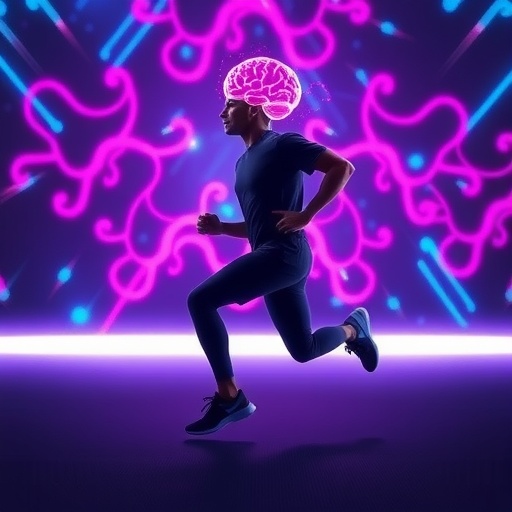In an era where digital entertainment is ubiquitous, Internet Gaming Disorder (IGD) has emerged as a pressing mental health challenge, striking primarily young adults and significantly impairing their psychological and social well-being. Recently, a groundbreaking study has shed new light on the neural underpinnings of IGD and a promising intervention strategy involving progressive aerobic training. Utilizing advanced neuroimaging techniques, the researchers explored how a structured, moderate-intensity exercise regimen can alter brain function and behavior in individuals afflicted by this disorder.
This randomised controlled trial, conducted with a cohort of college students diagnosed with IGD, sought to unravel the intricate relationship between physical exercise and neurocognitive outcomes. Eighty participants were recruited and randomly assigned to either a progressive aerobic training (PAT) group or a free training (FT) control group. Across six weeks, the PAT group underwent 20 supervised treadmill sessions where exercise intensity systematically increased from 46% to 55% of their maximal oxygen uptake (VO₂max), a critical metric in assessing cardiovascular fitness. The FT group, in contrast, engaged in exercise without prescriptive guidelines, allowing researchers to isolate the effects of a structured protocol.
The methodology extended beyond behavioral assessments, incorporating sophisticated functional magnetic resonance imaging (fMRI) to capture neural dynamics. Behavioral metrics included the Internet Addiction Test (IAT), the DSM-5 criteria for IGD, and the Questionnaire on Gaming Urge (QGU), all administered pre- and post-intervention. Central to the study’s innovation was the application of intersubject correlation (ISC) analysis, an advanced approach to measuring neural synchrony by quantifying the consistency of brain activity across individuals. Additionally, seed-based connectivity (SBC) analysis was employed to investigate alterations in functional coupling among addiction-relevant brain regions.
Findings from the trial were compelling and multidimensional. Participants in the PAT group exhibited significant reductions in IAT and DSM-5 scores, indicative of alleviated IGD symptomatology and diminished cravings. Notably, these behavioral improvements correlated with marked changes in neural synchrony: enhanced ISC was observed in the left postcentral gyrus—an area implicated in sensorimotor integration—while decreased ISC was detected in the left caudate and right precentral gyrus, regions deeply entrenched in reward processing and motor control. Such neuroplastic adaptations suggest a remodeling of dysfunctional neural circuits that support addictive behaviors.
Moreover, the study uncovered a salient relationship between caudate ISC modulations and IAT score improvements, highlighting the caudate nucleus as a potential biomarker for therapeutic efficacy. The SBC analysis further reinforced this finding by demonstrating reduced connectivity between the left caudate and right prefrontal cortex in individuals undergoing progressive aerobic training. This decoupling hints at a recalibration of the reward-related network and executive control mechanisms, which are often dysregulated in IGD.
These data collectively advance the notion that moderate, progressive aerobic training not only mitigates behavioral manifestations of IGD but also induces significant neural remodeling within the reward and control circuits of the brain. The implications are profound, as this physiologically accessible modality offers a low-cost, scalable intervention that circumvents the side effects associated with pharmacological treatments, while promoting holistic brain health.
Equally important, the study’s reliance on advanced neuroimaging and quantitative connectivity metrics bridges behavioral neuroscience with clinical psychology, offering a translational blueprint for future interventions. The integration of ISC as a marker of neural synchrony provides novel insight into the temporal dynamics of brain networks in addiction, while SBC elucidates the complexities of interregional communication, crucial for restoring cognitive control in affected individuals.
However, the authors urge caution in overgeneralizing these findings due to limitations such as sample size and study duration. They advocate for expanded, longitudinal research designs to validate and extend these preliminary observations. Such studies would ideally incorporate diversified populations, multimodal imaging, and neuroscientific assessments to unravel the long-term impact and mechanistic pathways by which aerobic exercise ameliorates IGD.
In summation, this pioneering investigation reveals that structured aerobic exercise can fundamentally alter brain function and connectivity disrupted in internet gaming disorder. The research presents caudate-related neural markers as promising targets for future monitoring and intervention. As society grapples with the burgeoning mental health crisis linked to excessive gaming, this work signals a hopeful paradigm shift towards accessible, nonpharmacological treatments grounded in neuroscience. The fusion of exercise science with neuroimaging heralds a new frontier in understanding and combating behavioral addictions.
Looking forward, the potential to harness physical activity to recalibrate dysfunctional neural systems opens exciting avenues for both clinical practice and public health strategies. By emphasizing neuroplasticity and resilience through manageable lifestyle modifications, such approaches may ultimately transform the landscape of addiction therapy. This study stands as a testament to the fruitful intersection of innovation, technology, and the enduring human capacity for recovery.
Subject of Research: Internet gaming disorder and its neural and behavioral modification through progressive aerobic training.
Article Title: Effects of progressive aerobic training on neural synchrony and functional connectivity in internet gaming disorder: a randomized controlled fMRI study
Article References:
Li, Q., Luo, X., Wei, M. et al. Effects of progressive aerobic training on neural synchrony and functional connectivity in internet gaming disorder: a randomized controlled fMRI study. BMC Psychiatry 25, 986 (2025). https://doi.org/10.1186/s12888-025-07419-6
Image Credits: AI Generated




